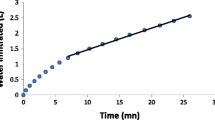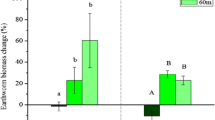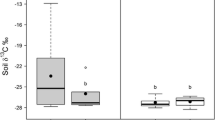Abstract
Earthworms feed on organic matter present at the soil surface or within the soil. Thus, its distribution in the soil profile is likely to greatly influence earthworm behavior and, in turn, their burrow system. To test this idea, two anecic and two endogeic earthworm species were introduced into repacked soil cores (depth = 30 cm) upper half filled with a top soil containing 4% organic matter (0–15 cm) and lower half filled with a deep soil at 2% organic matter (15–30 cm). Earthworm behavior was studied using X-ray tomography combined with luminophores (colored particulate tracers of 63–125 μm size) placed at 0, 3, and 12 cm depth, a method widely used in sediment ecology. We observed that anecic and endogeic earthworms had contrasting reactions to the conditions with only endogeic species burrowing more intensively in the upper part. From a quantitative point of view, only a few percent of luminophores were displaced. However, luminophore displacements also provided qualitative information to complement the tomography: (i) endogeic species and especially Aporrectodea caliginosa bioturbated the most soil close to the surface (3 cm depth) and (ii) the two anecic species influenced the luminophore distribution differentially with Lumbricus terrestris displacing significantly more luminophores, whatever their initial depth, than Aporrectodea nocturna due to intense surface cast activity. Beyond methodological developments, our study found that endogeic earthworms burrow more in zones with higher organic matter contents and this explains why they are mainly found close to the soil surface in non-tilled soils.



Similar content being viewed by others
References
Anschutz P, Ciutat A, Lecroart P, Gérino M, Boudou A (2012) Bioturbation effects by tubificids worms on freshwater sediment biogeochemistry. Aquatic Geochemistry 18:475–497
Auclerc A, Capowiez Y, Guérold F, Nahmani J (2013) Application of X-ray tomography to evaluate liming impact on earthworm burrowing activity in an acidic forest soil under laboratory conditions. Geoderma 202-203:45–50
Bastardie F, Capowiez Y, Renault P, Cluzeau D (2005a) A radio-labelled study of earthworm behaviour in artificial soil cores in term of ecological types. Biol Fertil Soils 41:320–327
Bastardie F, Capowiez Y, Cluzeau D (2005b) 3D characterization of earthworm burrow systems in natural soil cores collected in a 12-year-old pasture. Appl Soil Ecol 30:34–46
Bernier N (1998) Earthworm feeding activity and the development of the humus profile. Biol Fertil Soils 26:215–223
Black KS, Athey S, Wilson P, Evans D (2007) The use of particle tracking in sediment transport studies: a review. J Geol Soc 274:73–91
Bottinelli N, Zhou H, Capowiez Y, Zhang ZB, Qiu J, Jouquet P, Peng XH (2017) Earthworm burrowing activity of two non-Lumbricidae earthworm species incubated in soils with contrasting carbon content (Vertisol vs. Ultisol) Biol Fertil Soils 53:951-955
Bottinelli N, Hedde M, Jouquet P, Capowiez Y (2020) An explicit definition of earthworm ecological categories - Marcel Bouché’s triangle revisited. Geoderma 372:114361
Bouché MB (1972) Lombriciens de France. Ecologie et systématique, INRA, Paris
Bouché MB (1977) Stratégies lombriciennes. Ecol Bull 22:122–132
Boudreau BP (1986) Mathematics of tracer mixing in sediments 1. Spatially dependent, diffusive mixing. Am J Sci 286:1161–1198
Capowiez Y, Monestiez P, Belzunces L (2001) Burrow systems made by Aporrectodea nocturna and Allolobophora chlorotica in artificial cores: morphological differences and effects of interspecific interactions. Appl Soil Ecol 16:109–120
Capowiez Y, Sammartino S, Michel E (2011) Using X-ray tomography to quantify earthworm bioturbation non-destructively in repacked soil cores. Geoderma 162:124–131
Capowiez Y, Bottinelli N, Sammartino S, Michel E, Jouquet P (2015) Morphological and functional characterization of the burrow system of sin earthworm species (Lumbricidae). Biol Fertil Soils 51:869–877
Cook SMF, Linden DR (1996) Effect of food type and placement on earthworm (Aporrectodea tuberculata) burrowing and soil turnover. Biol Fertil Soils 21:201–206
Duport E, Stora G, Tremblay P, Gilbert F (2006) Effects of population density on the sediment mixing induced by the gallery-diffusor Hediste (Nereis) diversicolor O.F. Müller, 1776. J Exp Mar Biol Ecol 336:33–41
Foulquier A, Simon L, Gilbert F, Fourel F, Malard F, Mermillod-Blondin F (2010) Relative influences of DOC flux and subterranean fauna on microbial abundance and activity in aquifer sediments: new insights from 13C-tracer experiments? Freshwater Biol 55:1560–1576
Francis GS, Fraser PM (1998) The effects of three earthworm species on soil microporosity and hydraulic conductivity. Appl Soil Ecol 10:11–19
François F, Gérino M, Stora G, Durbec J-P, Poggiale J-C (2002) Functional approach to sediment reworking by gallery-forming macrobenthic organisms: modelling and application with the polychaete Nereis diversicolor. Mar Ecol Prog Ser 229:127–136
Frazao J, de Goede RGM, Capowiez Y, Pulleman MM (2019) Soil structure formation and organic matter distribution as affected by earthworm species interaction and crop residues placement. Geoderma 338:453–463
Gerard BM (1967) Factors affecting earthworms in pasture. Animal Ecology 36:235–252
Gérino M, Aller RC, Lee C, Cochran JK, Aller JY, Green MA, Hirschberg D (1998) Comparison of different tracers and methods used to quantify bioturbation during a spring bloom: 234-Thorium, luminophores and chlorophylla. Estuar Coast Shelf Sci 46:531–547
Gérino M, Frignani M, Mugnai C, Bellucci LG, Prevedelli P, Valentini A, Castelli A, Delmotte S, Sauvage S (2007) Bioturbation quantification and related organisms in the Venice Lagoon. Acta Oecologica-Intern J Ecol 32:14–25
Gilbert F, Hulth S, Strömberg N, Ringdahl K, Poggiale JC (2003) 2-D optical quantification of particle reworking activities in surface marine sediments. J Exp Mar Biol Ecol 285(286):251–263
Gilbert F, Hulth S, Grossi V, Poggiale JC, Desrosiers G et al (2007) Sediment reworking by marine benthic species from the Gullmar Fjord (Western Sweden): importance of faunal biovolume. J Exp Mar Biol Ecol 348:133–144
Gutiérrez Y, Ott D, Töpperwien M, Salditt T, Sherber C (2018) X-ray computed tomography and its potential in ecological research: a review of studies and optimization of specimen. Ecol Evol 8:7717–7732
Hedman JE, Gunnarsson JS, Samuelsson G, Gilbert F (2011) Particle reworking and solute transport by the sediment-living polychaetes Marenzelleria neglecta and Hediste diversicolor. J Exp Mar Biol Ecol 407:294–301
Hughes MS, Bull CM, Doube BM (1996) Microcosm investigations into the influence of sheep manure on the behaviour of the geophagous earthworms Aporrectodea trapezoides and Microscolex dubius. Biol Fertil Soils 22:71–75
Jégou D, Cluzeau D, Wolf HJ, Gandon Y, Tréhen P (1998) Assessment of the burrow system of Lumbricus terrestris, Aporrectodea giardi and Aporrectodea caliginosa using X-ray computed tomography. Biol Fertil Soils 26:116–121
Joschko M, Muller PC, Kotzke K, Dohring W, Larink O (1993) Earthworm burrow system-development assessed by means of X-ray computed tomography. Geoderma 56:209–221
Joyner JW, Harmon NP (1961) Burrows and oscillative behavior therein of Lumbricus terrestris. Proceedings of Indiana Academy of Science 71:378–384
Kobel-Lamparski A, Lamparski F (1987) Burrow construction during the development of Lumbricus badensis individuals. Biol Fert Soils 3:125–129
Kristensen E, Penha-Lopes G, Delefosse M, Valdemarsen T, Quintana CO, Banta G (2012) What is bioturbation? The need for a precise definition for fauna in aquatic sciences. Mar Ecol Prog Ser 446:285–303
Lagauzère S, Coppin F, Gérino M, Delmotte S, Stora G, Bonzom JM (2011) An alternative method of particulate fluorescent tracer analysis in sediments using a microplate fluorimeter. Environ Technol 32:551–560
Le Couteulx A, Wolf C, Hallaire V, Péres G (2015) Burrowing and casting activities of three endogeic earthworm species affected by organic matter location. Pedobiologia 58:97–103
Lee KE (1985) Earthworms. Their ecology and relationships with soil and land use. Academic Press, Sydney
Leroy BLM, Schmidt O, Van den Bossche A, Reheul D, Moens M (2008) Earthworm population dynamics as influenced by the quality of exogenous organic matter. Pedobiologia 52:139–150
Ligthart TN, Peek GJCW (1997) Evolution of earthworm burrow systems after inoculation of lumbricid earthworms in a pasture in the Netherlands. Soil Biol Biochem 29:453–462
Lindqvist S, Gilbert F, Eriksson SP, Hulth S (2013) Activities by Hediste diversicolor during light and dark conditions: experimental quantification of particle reworking using time-resolved imaging. J Exp Mar Biol Ecol 448:240–249
Mahaut ML, Graf G (1987) A luminophore tracer technique for bioturbation studies. Oceanol Acta 10:323–328
Maire O, Lecroart P, Meysman FJR, Rosenberg R, Duchene JC, Gremare A (2008) Methods of sediment reworking assessment in bioturbation research: a review. Aquatic Biology 2:219–238
McTavish MJ, Gorgolewski A, Murphy SD, Basiliko N (2019) Anecic earthworm (Lumbricus terrestris) facilitate the burial of surface-applied wood ash. Biol Fertil Soils 56:195–203
Mombo S, Laplanche C, Besson P, Sammartino S, Schreck E, Dumat C, Capowiez Y (2018) Metal soil pollution differentially affects both the behavior and exposure of A. caliginosa and L. terrestris: a mesocom. Biol Fertil Soils 54:319–328
Moreau-Valencogne P, Bertrand M, Holmstrup M, Roger-Estrade J (2013) Integration of thermal and hydrotime models to describe the development and growth of temperate earthworms. Soil Biol Biochem 63:50–60
Pelosi C, Grandeau G, Capowiez Y (2017) Temporal dynamics of earthworm-related microporosity in tilled and non-tilled cropping systems. Geoderma 289:169–177
Pierret A, Capowiez Y, Belzunces L, Moran CJ (2002) 3D reconstruction and quantification of micropores using X-ray computed tomography and image analysis. Geoderma 106:247–271
Rogasik H, Schrader S, Onasch I, Kiesel J, Gerke HH (2014) Micro-scale dry bulk density variation around earthworm (Lumbricus terrestris) burrows based on X-ray computed tomography. Geoderma 213:471–477
Rushton SP (1986) The effects of soil compaction on Lumbricus terrestris and its possible implications for populations on land reclaimed from open-cast coal mining. Pedobiologia 29:85–90
Schmidt S, Jouanneau J-M, Weber O, Lecroart P, Radakovitch O, Gilbert F, Jezequel D (2007) Sediment dynamic at the water-sediment interface of the Thau Lagoon (South France): from seasonal to century time scales using radiogenic and cosmogenic nuclides. Estuar Coast Shelf Sci 72:534–542
Shipitalo MJ, Butt KR (1999) Occupancy and geometrical properties of Lumbricus terrestris burrows affecting infiltration. Pedobiologia 43:782–794
Solan M, Wigham BD, Hudson IR, Kennedy R, Coulon CH et al (2004) In situ quantification of bioturbation using time-lapse fluorescent sediment profile imaging (f-SPI), luminophore tracers and model simulation. Mar Ecol Prog Ser 271:1–12
Springett J, Gray R (1997) The interaction between plant roots and earthworm burrows in pasture. Soil Biol Biochem 29:621–625
Taina IA, Heck RJ, Elliot TR (2013) Application of X-ray computed tomography to soil science: a literature review. Can J Soil Sci 88:1–20
Uvarov AV (2017) Density-mediated earthworm effects on soil respiration. Polish J Ecol 64:534–546
van Schaik L, Palm J, Klaus J, Zehe E, Schröder B (2014) Linking spatial earthworm distribution to macropore numbers and hydrological effectiveness Ecohydrology 7:401–408
Acknowledgments
The authors thank Georges Stora who provided relevant ideas in the earlier preparation of the work.
Funding
This study was financially supported by the Institute of Radioprotection and Nuclear Safety (IRSN, France). This is Nereis Park contribution number 42.
Author information
Authors and Affiliations
Corresponding author
Additional information
Publisher’s note
Springer Nature remains neutral with regard to jurisdictional claims in published maps and institutional affiliations.
Rights and permissions
About this article
Cite this article
Capowiez, Y., Gilbert, F., Vallat, A. et al. Depth distribution of soil organic matter and burrowing activity of earthworms—mesocosm study using X-ray tomography and luminophores. Biol Fertil Soils 57, 337–346 (2021). https://doi.org/10.1007/s00374-020-01536-y
Received:
Revised:
Accepted:
Published:
Issue Date:
DOI: https://doi.org/10.1007/s00374-020-01536-y




